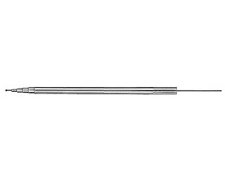
Categorised under:
Interventional Radiology
>
Uroradiology
>
PCNL dilators
A standard PCNL (percutaneous nephro lithotomy) requires a large percutaneous tract into the kidney to allow the passage of the nephroscope. This tract is usually dilated to 30F with a 32F Amplatz sheath left in situ for the nephroscope. Smaller tracts can be made (mini perc) but in our experience there is no advantage of this over the standard pcnl tract, even in young children. The disadvantage of miniperc is the smaller scope used with smaller working channels and less irrigation which will lead to a longer procedure time.
A standard PCNL (percutaneous nephro lithotomy) requires a large percutaneous tract into the kidney to allow the passage of the nephroscope.
This tract is usually dilated to 30F with a 32F Amplatz sheath left in situ for the nephroscope. Smaller tracts can be made (mini perc) but in our experience there is no advantage of this over the standard pcnl tract, even in young children. The disadvantage of miniperc is the smaller scope used with smaller working channels and less irrigation which will lead to a longer procedure time.
The dilators are made from stainless steel. The first dilator is braided and is flexible, although there is a rigid alternative. We dont tend to re use the first dilator but the remainder can be easily re sterilised which makes this a very cheap option.
There are nine dilators including the first. The first dilator also has a ball on the distal end that prevents the remainder of the dilators advancing beyond it.
In use
Click the related videos tab to view a video demonstrating the use of the metallic dilators (Storz) during a PCNL masterclass we performed recently at the Freeman Hospital in Newcastle upon Tyne (UK).
You can see that these dilators are easy to use and relatively quick. The final blunt end to the dilated tract means that the dilators and sheath can be placed right up to the stone.
A point to note is that you must not allow the kidney to be pushed away from the dilators as they are inserted as the relative movement will pull the dilators back along the tract. Also care must be taken not to kink the 1st dilator when dilating a steeply angled tract.
Click the related videos tab to view a video showing the use of the Nephromax balloon (Boston Scientific) during the Newcastle PCNL Masterclass. You should also see Dominic Fay's review of this device.
The balloon is also easy to use, but not good for staghorn calculi, cast calculi and calyceal diverticulae.
(Dr Rob Williams, Consultant Interventional Radiologist, Freeman Hospital.)
In our experience these dilators have proved reliable, durable and cost effective.
Time for tract dilatation is longer than for the nephromax balloon, but often not significant given the length of some of these procedures. This is certainly offset by the cost saving over balloon dilatation. If cost is not an issue, then its possible to use a balloon for most PCNLs.
Dr Phil Haslam, Consultant Interventional and Uroradiologist
Freeman Hospital, Newcastle, UK
No conflict declared.

Did you know you can Register for FREE with this website?
Registration gives you full access to all of the features of WhichMedicalDevice. Find out more ...
WhichMedicalDevice is a FREE resource created by clinicians for clinicians.
Registration is free and gives you unlimited access to all of the content and features of this website.
Find out more...Registration is free and gives you unlimited access to all of the content and features of Which Medical Device. Find out more...
Which Medical Device is a community of clinicians sharing knowledge and experience of the devices and procedures we use on a daily basis. We ask that our members register with us so that we can maintain the unbiased and independent nature of our content. Registration is quick and free.
We do not make your details available to any third parties nor do we send unsolicited emails to our members. You can read our Privacy Policy here.